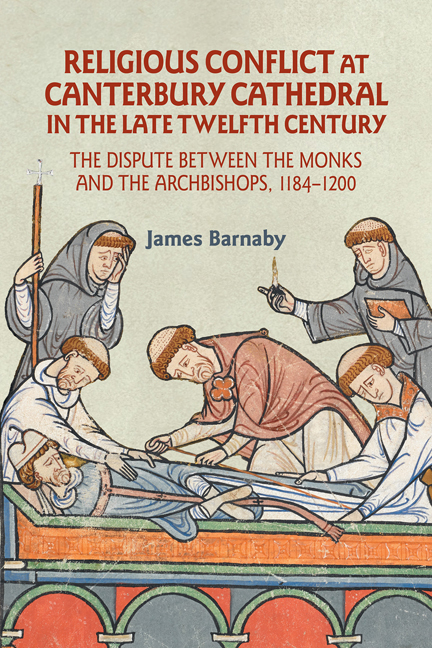 Religious Conflict at Canterbury Cathedral in the Late Twelfth Century
Religious Conflict at Canterbury Cathedral in the Late Twelfth Century Published online by Cambridge University Press: 09 May 2024
On 25 November 1186, Becket appeared in a vision to Brother Andrew John. In this vision (recorded in detail by Gervase) the martyr bade the monk rise from his bed and follow him into the tower next to the choir. There, Andrew John was shown a large Catherine wheel hurling blue flame. Andrew John asked the name of the man who was leading him. Becket replied, ‘I am Thomas your archbishop, who for this church and in this church suffered martyrdom.’ Withdrawing from the wheel, Andrew John saw Baldwin approaching the phenomenon. Taking three swords and leaning on each in turn to test their strength, the archbishop summoned Prior Honorius. On his arrival, Baldwin said to him ‘I wish to destroy this new work [the recent renovations to the cathedral in honour of Becket], and for this purpose I have made this wheel, but without you I cannot move it.’ The dismayed prior obeyed the archbishop and summoned the other monks to help him. Andrew John begged Becket to intervene. The saint drew his sword, inscribed with letters of gold, and suddenly the archbishop vanished. Becket gave his sword to Andrew John, showing him the inscription ‘Gladius beati Petri apostoli’. He ordered Andrew John to present the sword to Honorius who should use it to destroy the Catherine wheel. Reluctant to disturb the prior, Andrew John had the vision three times before he finally spoke of it. According to Gervase, the Catherine wheel was interpreted by Honorius as symbolic of the new church that Baldwin planned to build as well as a representation of the destruction of the convent if Baldwin's plan was to proceed. The prior interpreted the sword as representing the process of appeal to Rome. Just as St Peter had attempted to protect Christ with his sword, so would the successors of Peter protect the monks with their spiritual weapons.
According to the vision, it was Baldwin's desire to destroy the cathedral convent, and the blessed martyr's wish that the monks resist with all their strength. The depiction of the Hackington church as a Catherine wheel is significant, since the wheel was a device of torture, or execution, to which the victim would be tied so that their bones might be shattered. This was the method by which Emperor Maxentius had hoped to execute St Catherine.
To save this book to your Kindle, first ensure [email protected] is added to your Approved Personal Document E-mail List under your Personal Document Settings on the Manage Your Content and Devices page of your Amazon account. Then enter the ‘name’ part of your Kindle email address below. Find out more about saving to your Kindle.
Note you can select to save to either the @free.kindle.com or @kindle.com variations. ‘@free.kindle.com’ emails are free but can only be saved to your device when it is connected to wi-fi. ‘@kindle.com’ emails can be delivered even when you are not connected to wi-fi, but note that service fees apply.
Find out more about the Kindle Personal Document Service.
To save content items to your account, please confirm that you agree to abide by our usage policies. If this is the first time you use this feature, you will be asked to authorise Cambridge Core to connect with your account. Find out more about saving content to Dropbox.
To save content items to your account, please confirm that you agree to abide by our usage policies. If this is the first time you use this feature, you will be asked to authorise Cambridge Core to connect with your account. Find out more about saving content to Google Drive.